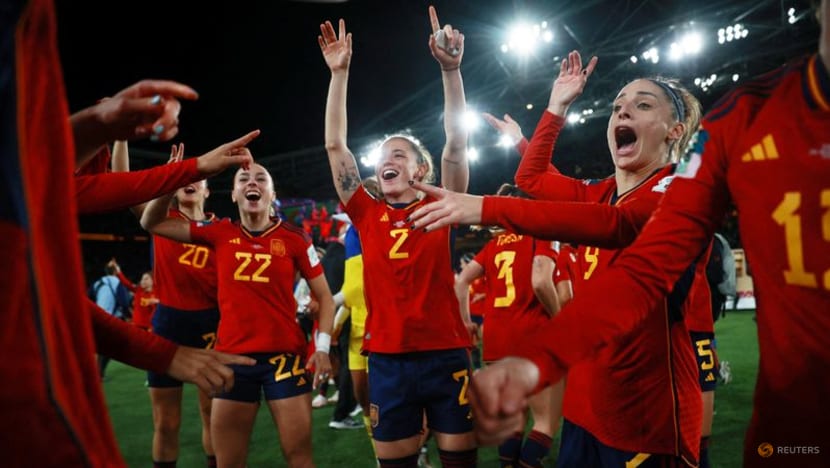Historic World Cup not just a victory for Spain, but a triumph for women’s football everywhere, say observers
Record-breaking numbers in ticket sales and viewership at this year’s FIFA Women’s World Cup have sparked hopes that women’s football will gain more sponsorships, funding and interest.

Spanish players celebrate at Stadium Australia in Sydney on Aug 20, 2023, after winning the FIFA Women's World Cup. (Photo: Reuters/Hannah McKay)
The FIFA Women’s World Cup, which broke records for ticket sales and television viewership, was a triumph for women’s football everywhere, observers said a day after Spain beat England to lift the trophy.
Spain defeated England 1-0 in the final on Sunday (Aug 20) to win their first title, capping a month-long tournament that kicked off with 32 teams – the biggest edition so far.
In total, almost 2 million spectators watched the games – about 600,000 more than the previous record set eight years ago in Canada – and surpassing FIFA’s expectations of 1.5 million.
In co-host nation Australia, their semi-final match against England created history when 11.15 million viewers tuned in at its peak to watch the 3-1 loss.
It became the most-watched television programme since the current audience measurement system started in 2001, the Australian Broadcasting Corporation said.
The record-breaking numbers have sparked hope in athletes, fans and observers that the tournament’s success will mean more sponsorships, viewership, funding and interest for women’s football, as well as women’s sports in general.
“(The World Cup) has suddenly shone a light on an area that perhaps politicians and the general public were not really thinking about,” consultancy firm Deloitte Southeast Asia’s sports business group leader James Walton told CNA’s Asia Now on Monday.
“People see the level of fan engagement, the level of impact on getting young people – particularly young girls in this case – to participate in the sport … And suddenly, people see that the women’s football teams can be just as successful as the men’s, if not more so.”
“WORLD CUP OF UNDERDOGS”
Observers said the World Cup – in its ninth edition – showed that women’s football has progressively gotten more competitive and exciting over the years.
Dubbing this the “World Cup of underdogs” Sydney Morning Herald sports reporter Billie Eder said that many teams that were not from traditional women’s football nations had had their day in the sun.
She said: “We had Colombia, in their most successful World Cup campaign. Nigeria, which almost beat England in their round of 16 game with a phenomenal performance. New Zealand, in their first World Cup win against Norway. There’s just so many success stories that came out of this (event).”
Mr Daanyal Saeed, a sports reporter with News Corp Australia, told CNA’s Asia First that this World Cup has shown the scope for development in women’s football.
“It’s amazing to see the depth in women’s football. We are only going to see more and more tournaments like this, and it makes for better viewing experiences for spectators and fans,” he said.
“Also, it is gratifying for women’s sports generally, not just women in football,” he added.
LEVEL PLAYING FIELD
It was also the first time that Spain and England made it to the final in a sport long dominated by the United States.
Women’s football powerhouse the US, which has had a place on the podium since the World Cup started in 1991 and was crowned champion four times, was booted out in the round of 16.
Related:
Mr Walton said the playing field is now more levelled and other nations have started to catch up.
“We have gone from the days where women had to play in the US (on a professional level) but now they can play in Spain, Germany, France, UK and other nations,” he said.
“The (better) pay is also encouraging women to take this up as a professional career instead of as a part-time on the side of their normal jobs. Hopefully, women’s football will become even more competitive and this resurgence will continue.”
Australia’s Matildas, despite losing to Sweden in the third-place playoff, captured the hearts of a nation.
Prime Minister Anthony Albanese has promised A$200 million (US$128 million) to improve women’s sporting facilities and equipment after the team’s success sparked calls for more funding.
“There’s no question about it. This past month, you can just see the change that women’s football, and just football in general, has had (on Australians). Jerseys were sold out across the country. Tickets were sold out,” Ms Eder told CNA938’s Asia First.
“It has proven just how successful the game is and how much hunger there is for people to watch this content. It’s definitely benefited world football and especially in those countries that – Australia being one of them – aren’t historically football nations. I think we’re going to see this wave continue,” she added.
LONG WAY TO GO
However, the sport still has a long way to go in terms of gender equality in pay, resources, opportunities and attention, especially in nations where women’s sports are on a different playing field, Mr Walton said.
He cited nations such as Jamaica, Nigeria and South Africa, where players had pay and funding issues ahead of the tournament.
Meanwhile, FIFA also struggled to sell broadcast rights, even at a fraction of the price of the men’s tournament, showing the huge disparity that still exists between men’s and women’s sports, he added.
“Sponsors are gradually warming up. Hopefully, the exposure of over 2 billion viewers watching the games around the world, and over 2 million spectators in the stadiums … will make people sit up and take notice," said Mr Walton.















